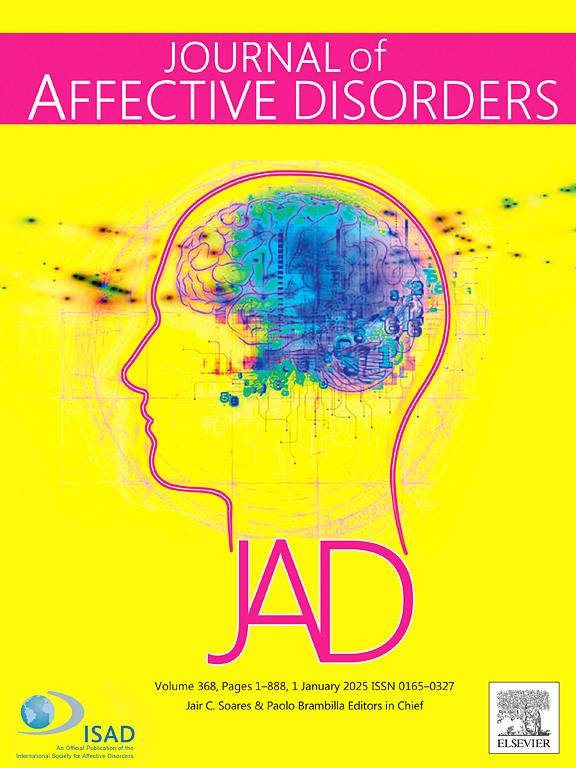比较不同经颅磁刺激靶向治疗抑郁症方法的疗效:荟萃分析。
IF 4.9
2区 医学
Q1 CLINICAL NEUROLOGY
引用次数: 0
摘要
背景:经颅磁刺激左背外侧前额叶皮层被广泛用于治疗重度抑郁症患者。使用“5 cm”、F3或神经导航方法定位左背外侧前额叶皮层。然而,治疗效果是否因使用的方法不同而不同尚不清楚。方法:遵循系统评价和荟萃分析报告指南的首选报告项目。选择随机对照试验,使用三种靶向方法中的至少一种来比较假药与主动经颅磁刺激的疗效,或比较主动经颅磁刺激中不同的靶向方法。数据由两位作者独立提取,差异由第三位作者解决。主要结果是抑郁症状严重程度的改变。次要结局是可接受性(退出率)和耐受性(不良事件发生率)。结果:网络涉及3080人的63个随机对照试验的荟萃分析显示,积极使用neuro-navigational经颅磁刺激(标准平均差 = 1.19,95 %置信区间 = 0.55 - -1.84)和“5 厘米”方法(标准平均差 = 1.13,95 %置信区间 = 0.79 - -1.47)比虚假的经颅磁刺激更大的抗抑郁效果。神经导航法在累积排序曲线下的表面积最高(79.3),其次是“5 cm”法(73.9)和F3法(40.1)。神经导航也表现出最低的退出率和最高的不良事件发生率。结论:与假经颅磁刺激相比,神经导航经颅磁刺激疗效好,可接受性高,耐受性低。本文章由计算机程序翻译,如有差异,请以英文原文为准。
Comparing efficacies of different transcranial magnetic stimulation targeting methods for depression: A meta-analysis
Background
Transcranial magnetic stimulation over the left dorsolateral prefrontal cortex is widely used to treat patients with major depressive disorder. The left dorsolateral prefrontal cortex is located using the “5 cm”, F3, or neuro-navigational methods. However, whether treatment efficacy differs according to the method used remains unclear.
Methods
The Preferred Reporting Items for Systematic Reviews and Meta-Analyses reporting guidelines were followed. Randomized controlled trials that compared the efficacy of sham with active transcranial magnetic stimulation using at least one of the three targeting methods or compared different targeting methods in active transcranial magnetic stimulation were selected. The data were independently extracted by two authors and discrepancies were resolved by a third author. The primary outcome was the change in the severity of depressive symptoms. The secondary outcomes were acceptability (drop-out rate) and tolerability (incidence of adverse events).
Results
Network meta-analysis of 63 randomized controlled trials involving 3080 participants showed that active transcranial magnetic stimulation using the neuro-navigational (standardized mean difference = 1.19, 95 % confidence interval = 0.55–1.84) and “5 cm” methods (standardized mean difference = 1.13, 95 % confidence interval = 0.79–1.47) had greater anti-depressant efficacy than sham transcranial magnetic stimulation. The neuro-navigational method had the highest surface under the cumulative ranking curve score (79.3), followed by the “5 cm” method (73.9) and the F3 method (40.1). Neuro-navigation also exhibited the lowest drop-out rate and the highest incidence of adverse events.
Conclusions
Transcranial magnetic stimulation using neuro-navigation was associated with good efficacy, high acceptability, and low tolerability compared with sham transcranial magnetic stimulation.
求助全文
通过发布文献求助,成功后即可免费获取论文全文。
去求助
来源期刊

Journal of affective disorders
医学-精神病学
CiteScore
10.90
自引率
6.10%
发文量
1319
审稿时长
9.3 weeks
期刊介绍:
The Journal of Affective Disorders publishes papers concerned with affective disorders in the widest sense: depression, mania, mood spectrum, emotions and personality, anxiety and stress. It is interdisciplinary and aims to bring together different approaches for a diverse readership. Top quality papers will be accepted dealing with any aspect of affective disorders, including neuroimaging, cognitive neurosciences, genetics, molecular biology, experimental and clinical neurosciences, pharmacology, neuroimmunoendocrinology, intervention and treatment trials.
 求助内容:
求助内容: 应助结果提醒方式:
应助结果提醒方式:


